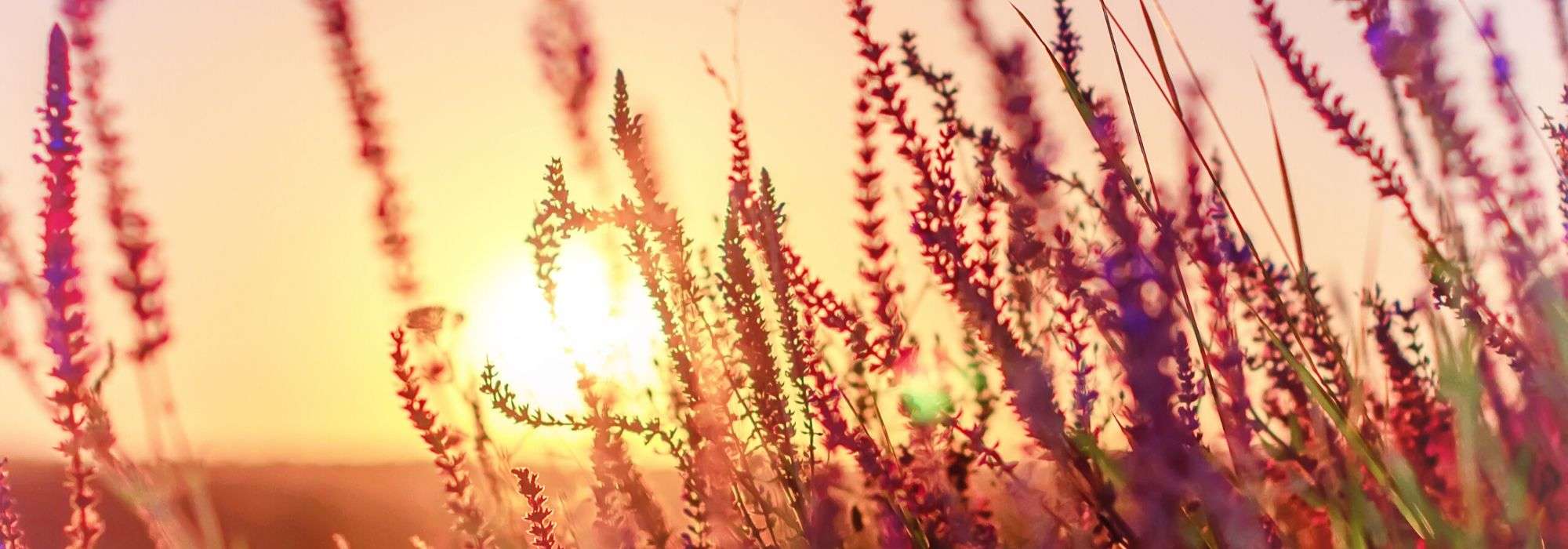
Lythrum: planting, care
Contents
Lythrum salicaria in a nutshell
- At home in wet areas, Lythrum or loosestrife is the ideal perennial plant to adorn the edges of water bodies, damp rockeries, or borders in marshy soil.
- It features a graceful summer flowering in spikes, typically pink and purple.
- Easy to grow, it prefers moist conditions, although it also thrives in any good garden soil that remains cool in summer.
- It requires no maintenance, except for watering if heat sets in.
- This tall hardy perennial with an upright habit adds verticality to naturalistic gardens.
A word from our expert
The purple loosestrife, Lythrum in Latin, is a vigorous perennial plant that thrives in moist or marshy soil. The common purple loosestrife, (Lythrum salicaria), also known as “herb of colic,” is the most widespread species in our gardens. A medicinal and edible plant, it possesses numerous properties and benefits concentrated in the form of capsules or mother tincture. Depending on the varieties, it displays long spikes of bright carmine flowers throughout the summer in Lythrum salicaria ‘Robert’, pale pink in Lythrum salicaria ‘Blush’, or purple-pink in Lythrum virgatum ‘Dropmore Purple’.
Purple loosestrife can be found in the wild along the banks of waterways and wet shores.
Preferring humid locations, it thrives near water bodies, in the cool areas of natural gardens where it forms spectacular clumps sometimes reaching up to 1.80 m! It can be cultivated both in borders that remain cool and in waterlogged containers. It sometimes ventures even into the water, keeping its stump partially submerged.
Vigorous and hardy, it will also accept any good garden soil as long as it remains cool and will require no maintenance, except for watering if the heat becomes too intense!
Discover our collection of purple loosestrifes, these beautiful perennials that are essential on the banks of a pond and in cool soils!
Description and botany
Botanical data
- Latin name Lythrum
- Family Lythraceae
- Common name Common loosestrife, Herb of colic
- Flowering June-September
- Height 0.45 to 2 m
- Exposure Sun, partial shade
- Soil type Heavy and moist
- Hardiness -15°C
Lythrum, also known as common loosestrife, is a perennial plant of moist or marshy soil. The genus comprises 35 species of perennials and annuals from the Lythraceae family. This herbaceous perennial, widely found in France, is native to Europe, North Africa, and northern Asia, where it grows spontaneously in ditches, by ponds and waterways, or in wet areas and meadows.
In our gardens, we mainly encounter Lythrum salicaria or common loosestrife with pink-purple spikes. This species has given rise to several horticultural forms with particularly coloured spikes, including ‘Blush’ or ‘Robert‘. The less common Lythrum virgatum, or “narrow-leaved loosestrife”, is truly spectacular, reaching heights of 1.80 m. The cultivars offer a wider range of pink shades than those observed in the typical species.
Anchored on a compact and powerful woody stump, with nodose rhizomes, the loosestrife quickly forms tall erect clumps ranging from 0.45 to nearly 2 m in height, depending on the varieties, and at least 50 cm wide. Due to this spreading root system and its propensity to self-seed, in certain areas (North America, Australia, Réunion Island), loosestrife is considered an invasive plant as it colonises wet areas.
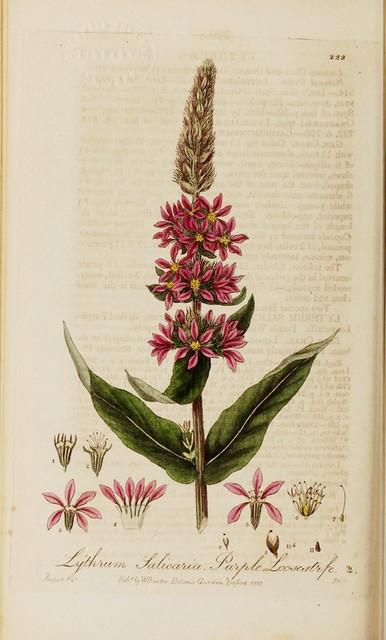
Lythrum salicaria – botanical illustration
The deciduous foliage consists of narrow, lanceolate, sessile leaves that embrace the stem, measuring 4 to 10 cm long. They are generally arranged oppositely along the robust, hairy, angular, and branched stems. The leaves somewhat resemble those of the willow, hence the name “salicaria“, derived from the Latin “salix” meaning “willow”. A beautiful bright green in summer, they take on sumptuous red-orange hues in autumn, with a paler underside. Some varieties exhibit purple foliage, such as Lythrum virgatum ‘The Rocket’.
On this dense yet elegant foliage, the loosestrife reveals a beautiful summer flowering with graceful high terminal inflorescences rising above the foliage.
From June-July to September, long floral spikes, spectacular in length from 25 to 45 cm, appear at the ends of the stems. They are densely packed with small star-shaped flowers made up of 6 crumpled petals, grouped in whorls of three. They bloom from the base to the top. These inflorescences vary in density depending on the varieties. Lythrum virgatum is distinguished by lighter and airier inflorescences.
They explore different shades of pink and mauve, depending on the species and varieties, ranging from magenta pink to pale pink, intense lilac-pink, bright carmine pink (‘The Beacon’), and purple pink (Lythrum virgatum ‘Dropmore Purple’). There are some rare forms such as Lythrum salicaria ‘Alba’ which have white flowers.
Highly nectariferous and melliferous, they delight butterflies, bees, and other pollinating insects all summer long.
They make beautiful cut flowers for fresh bouquets in summer.
These flowers are followed by the formation of small dehiscent capsules containing two small seeds, dispersed by water or birds, and prone to self-seeding if conditions are right, which can make loosestrife somewhat invasive.
Loosestrife is a hardy plant that withstands negative temperatures down to at least -15°C. It grows almost everywhere in France, except perhaps in Mediterranean climates, which are too dry and hot in summer: its only cultivation requirement is permanently moist soil.
It thrives in sun or partial shade, on moist banks, sometimes even partially submerged. It grows easily in all types of cool to moist, fertile, neutral to calcareous soil, as it does not appreciate very acidic soils. It will thrive in a naturalistic garden, by a water feature, pond, at the edge of a woodland, in a border, or any cool area of the garden where the soil remains heavy, moist, or even waterlogged.
Read also
12 perennials for heavy, wet soilMain species and varieties
Lythrums are primarily distinguished by their size and the colour of their flowers.
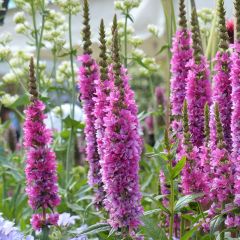
Lythrum salicaria Robert
- Flowering time August to October
- Height at maturity 80 cm
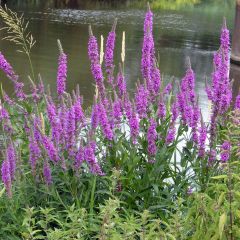
Lythrum salicaria The Beacon
- Flowering time August, September
- Height at maturity 60 cm
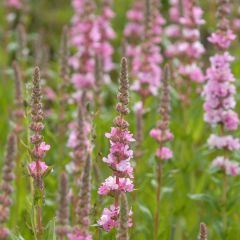
Lythrum salicaria Blush
- Flowering time August, September
- Height at maturity 90 cm
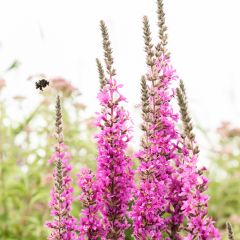
Lythrum virgatum Dropmore Purple
- Flowering time August, September
- Height at maturity 1,50 m
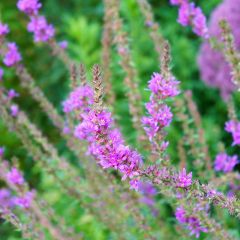
Lythrum salicaria Swirl
- Flowering time August, September
- Height at maturity 60 cm
Discover other Lythrum - Purple loosestrife
View all →Available in 3 sizes
Available in 3 sizes
Available in 1 sizes
Available in 2 sizes
Available in 1 sizes
Available in 1 sizes
Available in 1 sizes
Available in 1 sizes
Planting
Where to plant the purple loosestrife?
Hardy to at least -15 °C, purple loosestrife grows almost everywhere in France, except in Mediterranean climates, which are too dry in summer as it requires moist or at least cool soil. It will withstand summer heat in temperate regions, provided the soil remains consistently moist and cool. Its stump can also tolerate partial immersion under 10 cm of water.
It prefers full sun north of the Loire and partial shade, especially in the southern regions of our country. It is a sun-loving plant that needs bright exposure to thrive.
Its only requirement is permanently heavy and moist soil, even flooded, humus-bearing, deep, and fertile. It can tolerate clay soils but will refuse to grow in overly acidic or peaty soils.
Purple loosestrife is not invasive in our climates. So feel free to plant it near water bodies, along a damp bank, in a pond, or in a marshy area of your garden where it will brighten up with its vibrant flowering. With its light and structuring silhouette, it will also bring movement and verticality to borders, provided the soil never dries out in summer.
It also grows very well in a waterlogged container.
When to plant?
Planting of purple loosestrife should be done in spring from February to April after the frosts, or in autumn from September to November, after the heatwaves. In marshy areas, it can be planted all year round, except during frost periods.
How to plant purple loosestrife?
In the ground
Plant in a staggered pattern 3 plants of lythrum per m², spaced about 50 cm apart in all directions, favouring planting in small groups to create a beautiful effect.
- Soak the root ball in a bucket before planting
- Dig the soil deeply and clean it before planting
- Dig a hole 2 to 3 times larger than the root ball
- Add some compost to your garden soil if it is too poor
- Place the root ball and backfill to encase the roots
- Firm the soil and water generously during the first year of planting
- Mulch to keep the soil cool
In a pot
- In a large container, spread a good layer of drainage
- Plant the root ball in a mixture of potting soil and compost that is always moist
- Mulch and water very regularly, never allowing the substrate to dry out
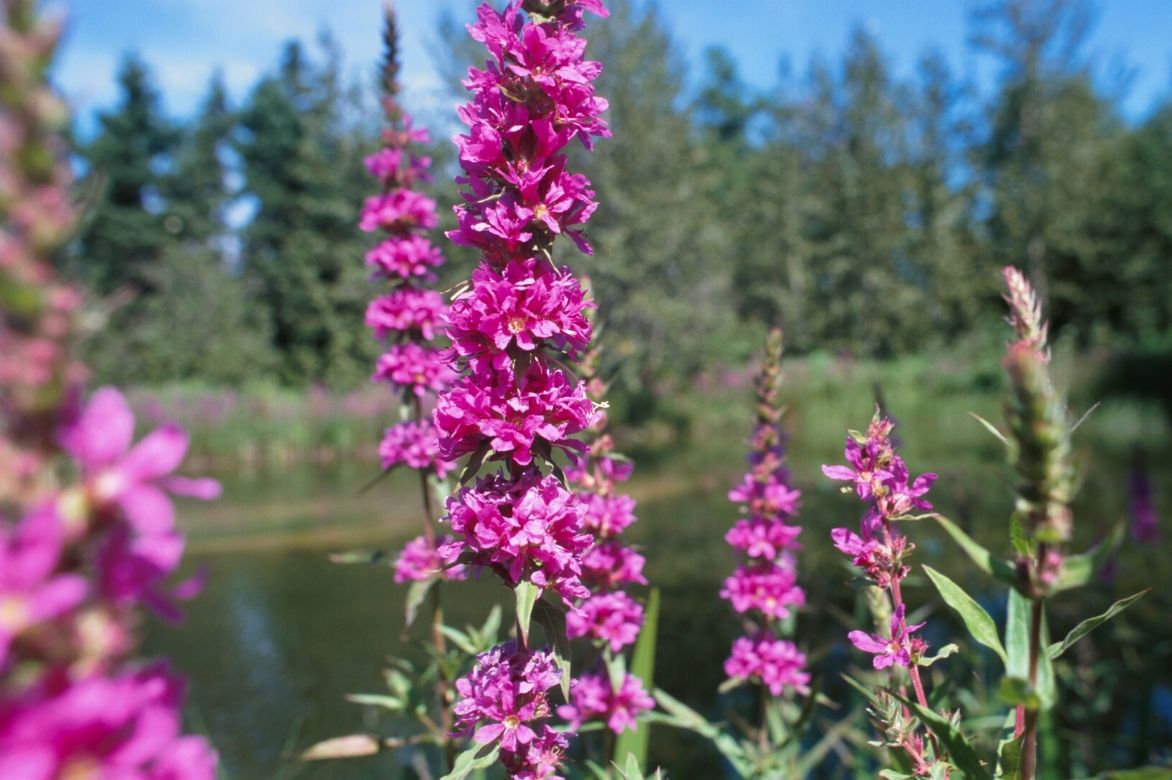
Read also
Gardening in heavy, wet soilMaintenance and care
Hardy and vigorous, once well established in cool, moist Purple Loosestrife requires little attention. Freshness and moisture in the soil are the secrets to its successful development.
Water regularly after planting, then in summer, especially if dry conditions set in: ensure that the soil never completely dries out, or you risk seeing it decline rapidly. In winter, reduce watering.
Keep the soil moist at the base with organic mulch (hemp, linseed flakes…) and renew this mulch during summer if necessary.
At the end of winter, spread a few handfuls of compost at the base of the plant. In pots, fertilise regularly with organic fertiliser during the flowering period.
Remove faded spikes as they appear to prevent seed formation: spontaneous sowing can make Purple Loosestrife somewhat invasive.
Harvest the seeds as the first frosts arrive to sow them in spring.
Cut back the clump to ground level in autumn or clean the stump in spring to remove dry parts.
When the first leaves appear, remember to protect them from the appetite of slugs that particularly enjoy damp areas. Discover our 7 ways to fight slugs effectively and naturally and how to make a slug trap.
Multiplication
If purple loosestrife multiplies easily by spontaneous sowing or with seeds harvested in autumn and sown in early spring (after stratification). Clump division is quicker and will allow you to maintain the plant as it is. This is done in spring, after the frosts, on well-rooted clumps.
Division
- Using a forked spade, dig up part of the stump after the vegetation has started
- With a spade, slice to retrieve one or more clumps
- Replant the clumps immediately in the garden in suitable soil
Pairing ideas
Lythrum is an essential plant in marsh gardens, where it brightens cool, damp areas with its colourful flowering. Its slender, upright silhouette fits easily among many summer perennials.
On the banks of a pond, combine it with other perennials for wet banks, airy Astilbes, Goat’s Beard, Liatris spicata, meadowsweet (Filipendula rubra ‘Venusta’), water iris, rodgersias, Veronicastrum virginicum, and knotweeds.
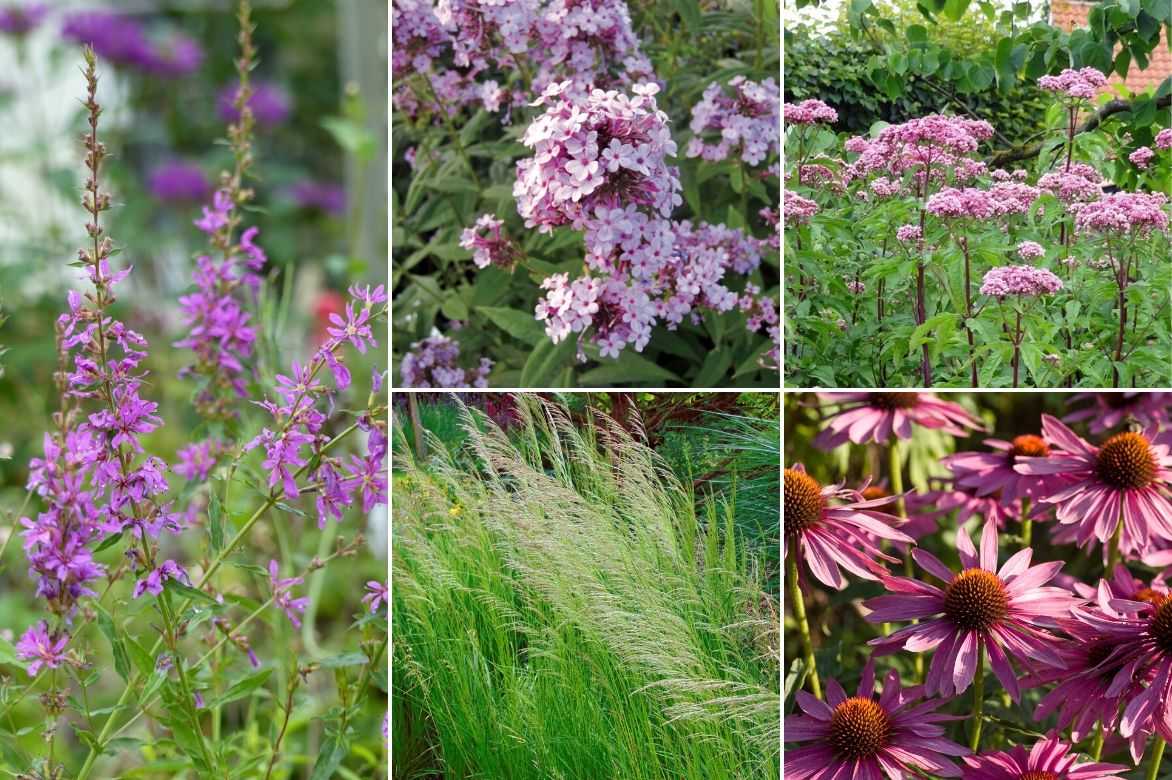
An example of a naturalistic association: Lythrum virgatum ‘Dropmore Purple’, Phlox paniculata ‘Jeana’, Eupatorium cannabinum ‘Plenum’, Deschampsia cespitosa ‘Goldscheiler’, Echinacea purpurea ‘Magnus’
Plant it alongside the lovely umbels of eupatoriums (Eupatorium maculatum ‘Atropurpureum’), Marsh Spurge, and ligularias with yellow spikes for a more contrasting effect, for example.
In a damp rockery, mix it with Marsh Geranium or Phlox. At the edge of a woodland, it makes a good companion for ferns, meadow-rues, Japanese anemones, and pulmonarias in pastel tones.
At the back of a wildflower bed, the larger varieties of loosestrife create a very successful association with tall grasses such as Miscanthus, Panicum, or Stipa.
In a border, in rather heavy and always moist soil, it forms a beautiful contrast in shape with the less flexible habit of osmunda and hostas among the perennials.
Did you know?
Purple loosestrife is a medicinal and edible plant that contains active principles. Its young leaves can be eaten raw in salads or cooked as a vegetable, while its fleshy stems can be enjoyed after cooking. Its flowers are used as a food dye, particularly for confectionery.
Commonly referred to as “colic herb”, it is a plant used for its anti-diarrhoeal properties, as well as antiseptic, healing, and haemostatic effects. In the 18th century, it was used to treat diarrhoea and dysentery. In herbal medicine, the aerial parts, flowering tops, and fresh juice are used. Its virtues are valued for treating venous insufficiency and certain skin conditions such as eczema. It can be used in the form of mother tincture, fluid extract, decoctions, lotions, powders, or ointments.
- Subscribe!
- Contents
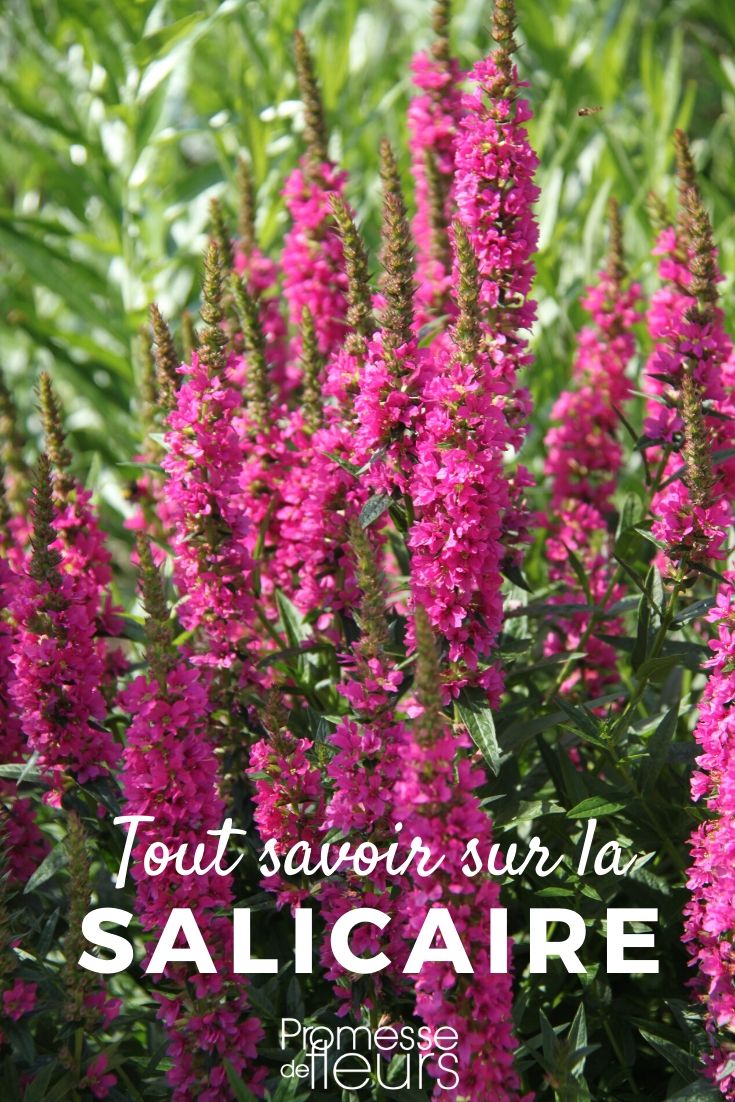































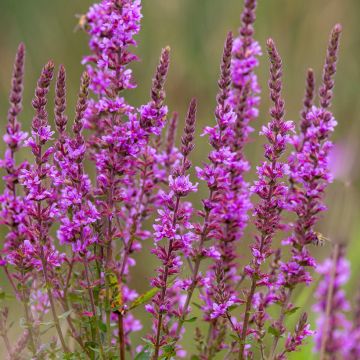



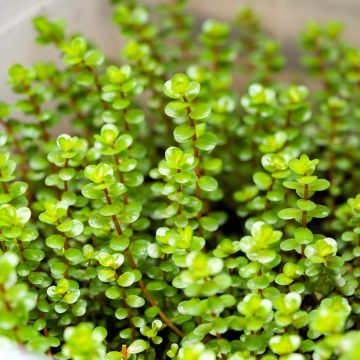
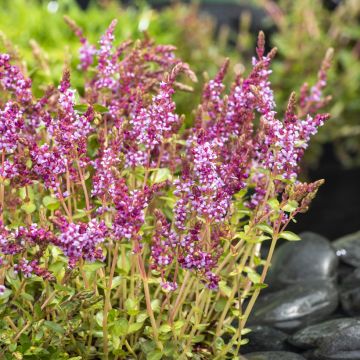


Comments